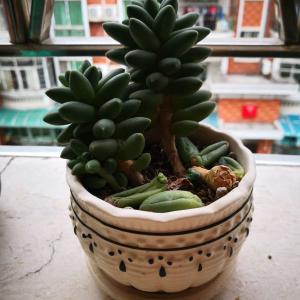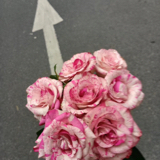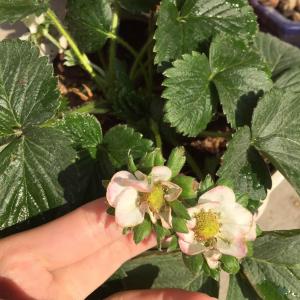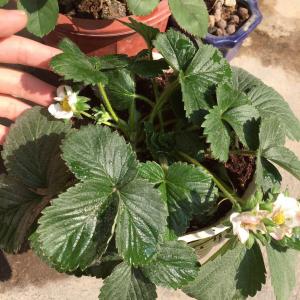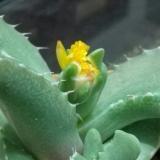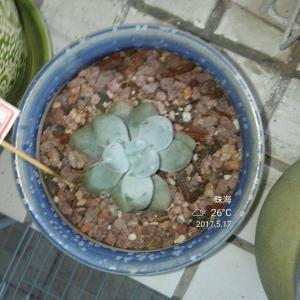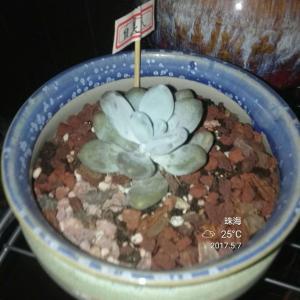Lisa Stout
2018年02月14日

Common: Silver Lupine, white-leaf bush lupine, or evergreen lupine
Botanical: Lupinus albifrons
Native: California
Size: 5 ft tall x 2 ft wide
Likes: full sun, good drainage, sandy or rocky soils that are dry, but will tolerate some moisture
Notes: deer resistant, bees, hummingbirds, and butterfly attractant, fragrant flowers


Botanical: Lupinus albifrons
Native: California
Size: 5 ft tall x 2 ft wide
Likes: full sun, good drainage, sandy or rocky soils that are dry, but will tolerate some moisture
Notes: deer resistant, bees, hummingbirds, and butterfly attractant, fragrant flowers


0
0
文章
Miss Chen
2018年02月13日

Description: This perennial plant is about 4-10' tall and remains unbranched, except for the panicle of flowering stems near the apex. The central stem is thick, hairless, and four-sided. The large opposite leaves are up to 8" long and 5" across, which join together around the central stem to form a cup that can hold water, hence the name of the plant. These leaves are broadly lanceolate to cordate, coarsely toothed, and have a rough, sandpapery texture. The yellow composite flowers bloom during early to mid-summer for about 1-1½ months. Each sunflower-like composite flower is about 3-4" across, consisting of numerous yellow disk florets that are surrounded by 18-40 yellow or pale yellow ray florets. The infertile disk florets protrude somewhat from the center and are rather conspicuous, while the ray florets are fertile. The latter produce thin achenes, each with a well-developed marginal wing, which are dispersed to some extent by the wind. The root system consists of a central taproot, and abundant shallow rhizomes that help to spread the plant vegetatively, often forming substantial colonies.

Cultivation: The preference is full or partial sun, and moist loamy soil. This plant may drop some of its lower leaves in response to a drought. Sometimes, the leaves and buds of distressed plants turn brown, growth becomes stunted, and blossums abort in response to disease or drought. Another problem is that Cup Plant may topple over during a rainstorm with strong winds, particularly while it is blooming, or situated on a slope.
Range & Habitat: The native Cup Plant occurs throughout Illinois, except for a few southern counties (see Distribution Map). It is fairly common. Typical habitats include moist black soil prairies, moist meadows near rivers, low-lying woodland edges and thickets, fens and seeps, lake borders, fence rows, and along ditches near railroads.

Faunal Associations: Long-tongued bees, butterflies, and skippers are common visitors and the most important pollinators of the flowers. Some short-tongued bees, wasps, bee flies, and other kinds of flies also visit the flowers for pollen or nectar. The larvae of an Antistrophus sp. (Gall Wasp sp.) feed within the stems of this plant, and may attract the hyperparasitic wasp Eurytoma lutea. Various birds, especially goldfinches, are very fond of the seeds, and drink water from the cups formed by the leaves. Because of the tendency to form dense colonies, this plant provides good cover for birds, which often lurk among the leaves during the heat of the day, searching for insects or pausing to rest. Large herbivores, especially cattle, may eat the eat leaves of Cup Plant, especially those of immature plants.
Photographic Location: The photographs of the flowering plants and perfoliate leaves were taken at a small restored prairie in Urbana, Illinois, while the photograph of the flowerhead close-up was taken at Meadowbrook Park in Urbana, Illinois.
Comments: This is an imposing, but attractive plant when it is in bloom. Cup Plant is easy to distinguish from other Silphium spp., as well as various sunflowers, by the perfoliate leaves that can hold water, and the hairless four-angled stems.

Cultivation: The preference is full or partial sun, and moist loamy soil. This plant may drop some of its lower leaves in response to a drought. Sometimes, the leaves and buds of distressed plants turn brown, growth becomes stunted, and blossums abort in response to disease or drought. Another problem is that Cup Plant may topple over during a rainstorm with strong winds, particularly while it is blooming, or situated on a slope.
Range & Habitat: The native Cup Plant occurs throughout Illinois, except for a few southern counties (see Distribution Map). It is fairly common. Typical habitats include moist black soil prairies, moist meadows near rivers, low-lying woodland edges and thickets, fens and seeps, lake borders, fence rows, and along ditches near railroads.

Faunal Associations: Long-tongued bees, butterflies, and skippers are common visitors and the most important pollinators of the flowers. Some short-tongued bees, wasps, bee flies, and other kinds of flies also visit the flowers for pollen or nectar. The larvae of an Antistrophus sp. (Gall Wasp sp.) feed within the stems of this plant, and may attract the hyperparasitic wasp Eurytoma lutea. Various birds, especially goldfinches, are very fond of the seeds, and drink water from the cups formed by the leaves. Because of the tendency to form dense colonies, this plant provides good cover for birds, which often lurk among the leaves during the heat of the day, searching for insects or pausing to rest. Large herbivores, especially cattle, may eat the eat leaves of Cup Plant, especially those of immature plants.
Photographic Location: The photographs of the flowering plants and perfoliate leaves were taken at a small restored prairie in Urbana, Illinois, while the photograph of the flowerhead close-up was taken at Meadowbrook Park in Urbana, Illinois.
Comments: This is an imposing, but attractive plant when it is in bloom. Cup Plant is easy to distinguish from other Silphium spp., as well as various sunflowers, by the perfoliate leaves that can hold water, and the hairless four-angled stems.
0
0
文章
Miss Chen
2018年02月12日

Description: This herbaceous perennial plant is 3-5' tall and unbranched, except near the inflorescence. The stout central stem is usually covered with stiff short hairs, but sometimes becomes glabrous with age. It is usually light green, but sometimes turns red in the presence of bright sunlight. The opposite leaves are up to 5" long and 2½" wide. They are broadly lanceolate to ovate, and have stiff small hairs on both the upper and lower sides, providing a sandpapery texture. The margins of these leaves are usually smooth, or they may have tiny teeth. As they ascend the stem, the opposite leaves rotate their direction by 90°.
A panicle of composite yellow flowers appear at the top of the plant, resembling small sunflowers. Each flower is about 2–3" across, consisting of numerous disk florets surrounded by 12-25 ray florets. Only the ray florets are fertile. There is no noticeable floral scent. Often, there are side stems that bear smaller panicles of flowers. The blooming period occurs from mid-summer to fall, and lasts about 1-2 months. The seeds are large, flat, and lightweight – they can be carried several feet by the wind. The root system consists of a taproot and short rhizomes, which enable this plant to form clumps. Several varieties of this plant have been reported by various authorities, some of which may be natural hybrids with other Silphium spp.
Cultivation: The preference is full sun and mesic to dry conditions. The soil can contain loam, clay-loam, or some gravel. Rosinweed is rarely bothered by disease and is easy to grow. It matures more quickly than many other members of the genus, such as Silphium terebinthinaceum (Prairie Dock) and Silphium laciniatum (Compass Plant). Another nice feature of this plant is that it rarely flops over in the flower garden, if the location isn't on a steep slope.

Range & Habitat: The native Rosinweed occurs throughout most of Illinois, except for a few southern and western counties (see Distribution Map). It is a fairly common plant. Habitats include mesic to dry black soil prairies, gravel prairies, clay prairies, hill prairies, openings in rocky upland forests, limestone glades, and areas along railroads, particularly where prairie remnants occur. This plant can survive significant degradation, and recovers readily from occasional wildfires. It competes well against most prairie grasses and forbs in mesic to dry areas.
Faunal Associations: The pollen and nectar of the flowers attract long-tongued bees primarily, including honeybees, bumblebees, Little Carpenter bees, Epeoline Cuckoo bees, Miner bees, and large Leaf-Cutting bees. Insects rarely attack this plant, although the Silphium Beetle (Rhynchites sp.) may feed on the flowers and seeds, and the caterpillars of the rare Tabenna silphiella (Silphium Moth) eat the epidermis of the leaves. The larvae of a Gall Wasp (Antistrophus sp.) may feed within the stems, forming galls that are invisible from the outside. They attract the hyperparasitic wasp Eurytoma lutea, whose larvae feed on the larvae of the Gall Wasp. Some butterflies occasionally visit the flowers, including Sulfurs and Painted Ladies. Other visitors include short-tongued bees and various flies. The seeds are eaten occasionally by Goldfinches. Small herbivores, such as rabbits, are less likely to eat this plant because of its height and the coarseness of its leaves. However, some large herbivores, such as cattle, readily consume the foliage, stems, and flowers.
Photographic Location: The photographs were taken at Meadowbrook Park in Urbana, Illinois.
Comments: Like other Silphium spp., Rosinweed has a fragrant resin while in flower, which was chewed as gum by Amerindian children. It is less dramatic in appearance than some of its gigantic cousins, but matures more quickly and tolerates drought as well or better. Rosinweed resembles many Helianthus spp. (Sunflowers), but its disk florets are sterile and ray florets are fertile. The Sunflowers, on the other hand, have fertile disk florets and sterile ray florets. Rosinweed tends to produce flowers earlier than the Sunflowers, but sometimes their blooming periods overlap. While this plant can form sizable clumps, it doesn't spread as aggressively by means of underground rhizomes as many Sunflower species, nor is it known to be allelopathic.
A panicle of composite yellow flowers appear at the top of the plant, resembling small sunflowers. Each flower is about 2–3" across, consisting of numerous disk florets surrounded by 12-25 ray florets. Only the ray florets are fertile. There is no noticeable floral scent. Often, there are side stems that bear smaller panicles of flowers. The blooming period occurs from mid-summer to fall, and lasts about 1-2 months. The seeds are large, flat, and lightweight – they can be carried several feet by the wind. The root system consists of a taproot and short rhizomes, which enable this plant to form clumps. Several varieties of this plant have been reported by various authorities, some of which may be natural hybrids with other Silphium spp.
Cultivation: The preference is full sun and mesic to dry conditions. The soil can contain loam, clay-loam, or some gravel. Rosinweed is rarely bothered by disease and is easy to grow. It matures more quickly than many other members of the genus, such as Silphium terebinthinaceum (Prairie Dock) and Silphium laciniatum (Compass Plant). Another nice feature of this plant is that it rarely flops over in the flower garden, if the location isn't on a steep slope.

Range & Habitat: The native Rosinweed occurs throughout most of Illinois, except for a few southern and western counties (see Distribution Map). It is a fairly common plant. Habitats include mesic to dry black soil prairies, gravel prairies, clay prairies, hill prairies, openings in rocky upland forests, limestone glades, and areas along railroads, particularly where prairie remnants occur. This plant can survive significant degradation, and recovers readily from occasional wildfires. It competes well against most prairie grasses and forbs in mesic to dry areas.
Faunal Associations: The pollen and nectar of the flowers attract long-tongued bees primarily, including honeybees, bumblebees, Little Carpenter bees, Epeoline Cuckoo bees, Miner bees, and large Leaf-Cutting bees. Insects rarely attack this plant, although the Silphium Beetle (Rhynchites sp.) may feed on the flowers and seeds, and the caterpillars of the rare Tabenna silphiella (Silphium Moth) eat the epidermis of the leaves. The larvae of a Gall Wasp (Antistrophus sp.) may feed within the stems, forming galls that are invisible from the outside. They attract the hyperparasitic wasp Eurytoma lutea, whose larvae feed on the larvae of the Gall Wasp. Some butterflies occasionally visit the flowers, including Sulfurs and Painted Ladies. Other visitors include short-tongued bees and various flies. The seeds are eaten occasionally by Goldfinches. Small herbivores, such as rabbits, are less likely to eat this plant because of its height and the coarseness of its leaves. However, some large herbivores, such as cattle, readily consume the foliage, stems, and flowers.
Photographic Location: The photographs were taken at Meadowbrook Park in Urbana, Illinois.
Comments: Like other Silphium spp., Rosinweed has a fragrant resin while in flower, which was chewed as gum by Amerindian children. It is less dramatic in appearance than some of its gigantic cousins, but matures more quickly and tolerates drought as well or better. Rosinweed resembles many Helianthus spp. (Sunflowers), but its disk florets are sterile and ray florets are fertile. The Sunflowers, on the other hand, have fertile disk florets and sterile ray florets. Rosinweed tends to produce flowers earlier than the Sunflowers, but sometimes their blooming periods overlap. While this plant can form sizable clumps, it doesn't spread as aggressively by means of underground rhizomes as many Sunflower species, nor is it known to be allelopathic.
0
0
文章
Miss Chen
2018年02月11日

Description: This perennial plant is 2½-5' tall; it is unbranched, or with a few small stems near the inflorescence. The central stem is ridged and slightly pubescent. The opposite leaves are greyish green, narrowly lanceolate, with serrated or dentate margins toward their tips. They are about 3-5" long and ¾" wide, becoming linear and shorter near the inflorescence. The foliage exudes a sage scent and has a sage taste.
There is one or more whorled spikes of flowers toward the apex of the plant that are up to 1' long. The corolla of these flowers ranges in color from pale blue to deep dark blue, usually with a lighter-colored throat. The corolla is short and tubular, dividing into a small upper lobe and a large lower lobe that functions as a landing pad for visiting insects. The tubular calyx is dull green, longitudinally ridged, pubescent, and bluntly toothed. Each flower is about ¾" long from top to bottom. The blooming period occurs during the late summer and fall, and lasts about 1-2 months. There is no floral scent. Only a few flowers are in bloom at the same time. The root system consists of a large central taproot, from which several stems may be produced.
Cultivation: The preference is full sun and dry, well-drained conditions. Different kinds of soil are acceptable, including those that contain significant amounts of loam, clay, or gravel. A high pH is tolerated. The seed germinates readily, often producing flowering plants during the first year. This is a surprisingly easy plant to grow, with few problems from disease. If the soil is too moist and fertile, or sunlight is insufficient, plants may become spindly and flop over while blooming later in the year.

Habitat & Range: Wild Blue Sage is a rare plant in Illinois with state-listed 'threatened' status. It has been reported from only a few scattered counties, primarily in central and southern Illinois (see Distribution Map). Some authorities assume that this plant is adventive from the west, while others regard it as native to the state. Habitats include dry, upland areas of black soil prairies, gravel prairies, limestone glades, roadsides, and miscellaneous waste areas. This plant would likely thrive in dolomite prairies and hill prairies, although it has not been observed in such areas.
Faunal Associations: Long-tongued bees visit the flowers for nectar, especially bumblebees. Halictid bees occasionally collect pollen, but they are non-pollinating. Less often, butterflies and skippers may visit the flowers for nectar, including Epargyreus clarus (Silver-Spotted Skipper). The caterpillars of the moth Sphinx eremitus (Hermit Sphinx) may feed on the foliage. Mammalian herbivores usually avoid this plant as a food source – apparently they dislike the sage scent, or perhaps the scent is associated with indigestion from chemicals that disrupt bacterial populations in their digestive tracts.
Photographic Location: The photographs of the flowering plant and flower close-up were taken at Meadowbrook Park, Urbana, Illinois, while the photograph of the leaf was taken at the wildflower garden of the webmaster in the same city and state.

Comments: This is a wonderful plant with attractive blue flowers – a pleasant alternative to the preponderance of goldenrods and asters during the fall. It can be confused with no other plant within the state. Wild Blue Sage is more common in states that lie west of the Mississippi River, such as Nebraska and Missouri. In Illinois, only small remnant populations exist. A different variety occurs in some southeastern states, Salvia azurea azurea, which has less showy flowers. In the past, the scientific name for Salvia azurea grandiflora was Salvia pitcheri, and it is still referred to as Pitcher's Sage by some authorities.
There is one or more whorled spikes of flowers toward the apex of the plant that are up to 1' long. The corolla of these flowers ranges in color from pale blue to deep dark blue, usually with a lighter-colored throat. The corolla is short and tubular, dividing into a small upper lobe and a large lower lobe that functions as a landing pad for visiting insects. The tubular calyx is dull green, longitudinally ridged, pubescent, and bluntly toothed. Each flower is about ¾" long from top to bottom. The blooming period occurs during the late summer and fall, and lasts about 1-2 months. There is no floral scent. Only a few flowers are in bloom at the same time. The root system consists of a large central taproot, from which several stems may be produced.
Cultivation: The preference is full sun and dry, well-drained conditions. Different kinds of soil are acceptable, including those that contain significant amounts of loam, clay, or gravel. A high pH is tolerated. The seed germinates readily, often producing flowering plants during the first year. This is a surprisingly easy plant to grow, with few problems from disease. If the soil is too moist and fertile, or sunlight is insufficient, plants may become spindly and flop over while blooming later in the year.

Habitat & Range: Wild Blue Sage is a rare plant in Illinois with state-listed 'threatened' status. It has been reported from only a few scattered counties, primarily in central and southern Illinois (see Distribution Map). Some authorities assume that this plant is adventive from the west, while others regard it as native to the state. Habitats include dry, upland areas of black soil prairies, gravel prairies, limestone glades, roadsides, and miscellaneous waste areas. This plant would likely thrive in dolomite prairies and hill prairies, although it has not been observed in such areas.
Faunal Associations: Long-tongued bees visit the flowers for nectar, especially bumblebees. Halictid bees occasionally collect pollen, but they are non-pollinating. Less often, butterflies and skippers may visit the flowers for nectar, including Epargyreus clarus (Silver-Spotted Skipper). The caterpillars of the moth Sphinx eremitus (Hermit Sphinx) may feed on the foliage. Mammalian herbivores usually avoid this plant as a food source – apparently they dislike the sage scent, or perhaps the scent is associated with indigestion from chemicals that disrupt bacterial populations in their digestive tracts.
Photographic Location: The photographs of the flowering plant and flower close-up were taken at Meadowbrook Park, Urbana, Illinois, while the photograph of the leaf was taken at the wildflower garden of the webmaster in the same city and state.

Comments: This is a wonderful plant with attractive blue flowers – a pleasant alternative to the preponderance of goldenrods and asters during the fall. It can be confused with no other plant within the state. Wild Blue Sage is more common in states that lie west of the Mississippi River, such as Nebraska and Missouri. In Illinois, only small remnant populations exist. A different variety occurs in some southeastern states, Salvia azurea azurea, which has less showy flowers. In the past, the scientific name for Salvia azurea grandiflora was Salvia pitcheri, and it is still referred to as Pitcher's Sage by some authorities.
0
0
文章
Miss Chen
2018年02月10日

Description: This perennial wildflower forms a small clump of basal leaves about 6-12" across, later developing leafy flowering stalks about 2' tall. The blades of the basal leaves are 2-5" long and about 3/8" (9 mm.) across, tapering gradually into slender petioles about 1-3" long (3-8" total length). The blades of the alternate leaves are 2-4" long and about 3/8" (9 mm.) across; they are sessile or clasp the flowering stalks slightly. Both basal and alternate leaves are medium green and hairy on both their lower and upper sides; they are linear-oblong or linear-oblanceolate and usually smooth along their margins. Sometimes a few widely spaced and shallow teeth are visible along the leaf margins.
The flowering stalks are light green or pale brownish green, terete, and unbranched; they are covered with abundant spreading hairs. Alternate leaves with ascending blades are restricted to the lower one-half of each stalk, while the upper half of the stalk is naked. Each stalk terminates in a single flowerhead about 2–2½" across. Numerous disk florets are concentrated in the center of the flowerhead; they are dark brown or black. The ray florets are located along the margins of the flowerhead, forming 8-13 petal-like yellow rays. The disk florets are fertile, while the ray florets are sterile. The base of each flowerhead is defined by an overlapping series of floral bracts (phyllaries) that are green, hairy, and lanceolate-oblong in shape. The blooming period occurs from mid-summer to early fall and lasts 1-2 months. At maturity, the disk florets are replaced by oblongoid achenes
g. At its apex, each achene has a crown of tiny scales. The root system is fibrous. This wildflower reproduces by reseeding itself.
Stem & Leaves
Cultivation: The preference is full sun, dry-mesic conditions, and a thin rocky soil that is calcareous (typically containing limestone or dolomite). Because this is one of the less aggressive coneflowers, taller and more aggressive plants should be kept away from it.
Range & Habitat: The native Missouri Coneflower has been found in only a few counties in southern Illinois (see Distribution Map); it is considered rare and state-listed as 'endangered.' This wildflower is found primarily in hilly areas of Arkansas and Missouri; in neighboring states, it is rare. Habitats consist of hill prairies, limestone and dolomite glades, and barren scrubby savannas in upland areas. This wildflower is found in high quality natural areas. While it is less popular than some other Rudbeckia spp. (Black-Eyed Coneflowers), it is also cultivated in gardens.
Faunal Associations: The nectar and pollen of the flowerheads attract a wide variety of insects, including long-tongued bees, short-tongued bees, wasps, flies, beetles, butterflies, and skippers. Two species of bee are specialist pollinators (oligoleges) of this and other Rudbeckia spp. (Black-Eyed Coneflowers): Andrena rudbeckiae and Heterosarus rudbeckiae. Miscellaneous insects feed on the foliage and other parts of these species: this includes the caterpillars of the butterflies Chlosyne nycteis (Silvery Checkerspot) and Chlosyne gorgone (Gorgone Checkerspot), the caterpillars of several moths, the leaf beetles Microrhopala excavata and Paria thoracica, and some aphids (see the Insect Table for a listing of these species).
Photographic Location: The wildflower garden of the webmaster in Urbana, Illinois.
Comments: This perennial coneflower looks like a Black-Eyed Susan (Rudbeckia hirta) with skinny leaves (usually less than ½" across). It is one of the coneflowers with widely spreading rays that don't droop downward. Like some other species in this genus, the petaloid rays along the margins of the flowerheads appear to be solid yellow to the human eye, but to bees and other flower-visiting insects they appear to be bicolored instead. This is because the outer one-half of each ray reflects ultraviolet light, while the inner one-half doesn't. Unlike the human eye, the eyes of bees and many other insects can detect ultraviolet light. Therefore, the flowerheads are actually more showy than one would assume.
The flowering stalks are light green or pale brownish green, terete, and unbranched; they are covered with abundant spreading hairs. Alternate leaves with ascending blades are restricted to the lower one-half of each stalk, while the upper half of the stalk is naked. Each stalk terminates in a single flowerhead about 2–2½" across. Numerous disk florets are concentrated in the center of the flowerhead; they are dark brown or black. The ray florets are located along the margins of the flowerhead, forming 8-13 petal-like yellow rays. The disk florets are fertile, while the ray florets are sterile. The base of each flowerhead is defined by an overlapping series of floral bracts (phyllaries) that are green, hairy, and lanceolate-oblong in shape. The blooming period occurs from mid-summer to early fall and lasts 1-2 months. At maturity, the disk florets are replaced by oblongoid achenes

g. At its apex, each achene has a crown of tiny scales. The root system is fibrous. This wildflower reproduces by reseeding itself.
Stem & Leaves
Cultivation: The preference is full sun, dry-mesic conditions, and a thin rocky soil that is calcareous (typically containing limestone or dolomite). Because this is one of the less aggressive coneflowers, taller and more aggressive plants should be kept away from it.
Range & Habitat: The native Missouri Coneflower has been found in only a few counties in southern Illinois (see Distribution Map); it is considered rare and state-listed as 'endangered.' This wildflower is found primarily in hilly areas of Arkansas and Missouri; in neighboring states, it is rare. Habitats consist of hill prairies, limestone and dolomite glades, and barren scrubby savannas in upland areas. This wildflower is found in high quality natural areas. While it is less popular than some other Rudbeckia spp. (Black-Eyed Coneflowers), it is also cultivated in gardens.
Faunal Associations: The nectar and pollen of the flowerheads attract a wide variety of insects, including long-tongued bees, short-tongued bees, wasps, flies, beetles, butterflies, and skippers. Two species of bee are specialist pollinators (oligoleges) of this and other Rudbeckia spp. (Black-Eyed Coneflowers): Andrena rudbeckiae and Heterosarus rudbeckiae. Miscellaneous insects feed on the foliage and other parts of these species: this includes the caterpillars of the butterflies Chlosyne nycteis (Silvery Checkerspot) and Chlosyne gorgone (Gorgone Checkerspot), the caterpillars of several moths, the leaf beetles Microrhopala excavata and Paria thoracica, and some aphids (see the Insect Table for a listing of these species).
Photographic Location: The wildflower garden of the webmaster in Urbana, Illinois.
Comments: This perennial coneflower looks like a Black-Eyed Susan (Rudbeckia hirta) with skinny leaves (usually less than ½" across). It is one of the coneflowers with widely spreading rays that don't droop downward. Like some other species in this genus, the petaloid rays along the margins of the flowerheads appear to be solid yellow to the human eye, but to bees and other flower-visiting insects they appear to be bicolored instead. This is because the outer one-half of each ray reflects ultraviolet light, while the inner one-half doesn't. Unlike the human eye, the eyes of bees and many other insects can detect ultraviolet light. Therefore, the flowerheads are actually more showy than one would assume.
0
0
成长记
Koala小熊
2018年02月08日

小貓爪四個月大囉~
自從一個半月前幫它換住5吋盆,感覺長得更好了!
小貓爪長得很多很緻密,細毛變多,葉色也更綠了
感覺比它的近親「熊童子」還要可愛呢(^^)
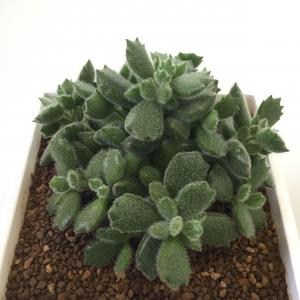
自從一個半月前幫它換住5吋盆,感覺長得更好了!
小貓爪長得很多很緻密,細毛變多,葉色也更綠了
感覺比它的近親「熊童子」還要可愛呢(^^)

0
0
成长记
Koala小熊
2018年02月08日

之前扦插和葉插的小熊童子轉眼也四個半月大了
中間陸續有被認養走4、5株
目前這五株還被主人寄放在熊這兒的感覺長得都很不錯呢(^^)
希望未來它們的新主人們也可以好好的照顧

中間陸續有被認養走4、5株
目前這五株還被主人寄放在熊這兒的感覺長得都很不錯呢(^^)
希望未來它們的新主人們也可以好好的照顧

0
0
文章
Miss Chen
2018年02月08日

Description: This herbaceous perennial wildflower is 2-5' tall with an erect central stem that is unbranched. This stem is light green, terete, stout, and covered with short stiff hairs; it often becomes brown with age. The alternate leaves are up to 4½" and 2" across, becoming gradually smaller as they ascend the stem. They are lanceolate to broadly lanceolate, elliptic, orClose-up of Flowerhead oblanceolate in shape, medium green, and covered with short stiff hairs on their undersides. The margins of the lower leaves are dentate, while the margins of the upper leaves are more smooth. Most of the leaves are sessile, although some of the lower leaves may clasp the stem slightly; some of these leaves may wither before the blooming period. The foliage contains a bitter white latex. The central stem terminates in a spike-like raceme (or something similar to this) about ½–2' long. Along the central stalk of this raceme, are small clusters of flowerheads; small clusters of flowerheads also develop from the axils of the upper leaves. Each flowerhead is about ½–1" across, consisting of 10-18 ray florets and no disk florets. Each of these ray florets is white or cream-colored, linear-oblong in shape, and truncate at its tip with 5 small teeth. The base of each flowerhead is about ½" long and cylindrical in shape; it is covered with 8-10 phyllaries (floral bracts) that are light green, conspicuously hairy, and linear-oblong in shape. At the bottom of the flowerhead's base, there are several secondary phyllaries that are much smaller in size and insignificant. The reproductive organs of the ray florets consist of divided styles with strongly recurved tips and elongated stamens. The blooming period occurs from late summer to early fall and lasts about 2-3 weeks. Each fertile floret is replaced by an oblongoid achene with a small tuft of hairs. These hairs are straw-colored or light brown. Distribution of the achenes is provided by the wind. The root system consists of a stout taproot that is broadest toward the middle. This plant reproduces by reseeding itself.
Cultivation: The preference is full sun and mesic to dry conditions. Different kinds of soil are tolerated, including those that are loamy, rocky, or sandy. It is difficult to establish this plant from seed as it is slow-growing and the young seedlings are vulnerable to "damping off" and other problems.
Range & Habitat: Rough White Lettuce exists in widely scattered populations throughout Illinois (see Distribution Map), where it is native. Populations of this species have declined and it has become rather uncommon, largely because of the destruction of prairie habitat throughout the state. Habitats include black soil prairies, sand prairies, savannas, rocky upland woodlands, limestone glades, and prairie remnants along railroads. At one time, Rough White Lettuce was considered a weed in pastures, but this is no longer the case. Today, this conservative species is typically found in high quality prairies. Because of the difficulty in propagating this species, it is not often used in prairie restorations.
Faunal Associations: There is a paucity of records about floral-faunal relationships for this species. Bumblebees visit the flowerheads for nectar. Cattle and other mammalian herbivores usually leave this plant alone because of its rough hairy foliage and bitter latex (see Ada Georgia, A Manual of Weeds, 1913).

Photographic Location: The photograph of the flowerhead was taken by Pat Chapel (Copyright © 2006) at the Prospect Cemetery Prairie in Ford County, Illinois, while the photograph of the stem and leaves was taken by the webmaster at Loda Cemetery Prairie in Iroquois County of the same state.
Comments: This is a true prairie plant that blooms during the fall. It is somewhat similar in appearance to Prenanthes racemosa (Glaucous White Lettuce), which prefers moist habitats. This latter species has a central stem that is glabrous and glaucous throughout, while the central stem of Rough White Lettuce has stiff short hairs. The color of the flowerheads is also somewhat different: the flowerheads of Glaucous White Lettuce often have a pale purple tint, while those of Rough White Lettuce are cream-colored or white. Other Prenanthes spp. in Illinois are normally found in woodlands, rather than prairies. In contrast to Rough White Lettuce, these woodland species have nodding flowerheads, widely spreading inflorescences, and leaves that are often deeply lobed.
Cultivation: The preference is full sun and mesic to dry conditions. Different kinds of soil are tolerated, including those that are loamy, rocky, or sandy. It is difficult to establish this plant from seed as it is slow-growing and the young seedlings are vulnerable to "damping off" and other problems.
Range & Habitat: Rough White Lettuce exists in widely scattered populations throughout Illinois (see Distribution Map), where it is native. Populations of this species have declined and it has become rather uncommon, largely because of the destruction of prairie habitat throughout the state. Habitats include black soil prairies, sand prairies, savannas, rocky upland woodlands, limestone glades, and prairie remnants along railroads. At one time, Rough White Lettuce was considered a weed in pastures, but this is no longer the case. Today, this conservative species is typically found in high quality prairies. Because of the difficulty in propagating this species, it is not often used in prairie restorations.
Faunal Associations: There is a paucity of records about floral-faunal relationships for this species. Bumblebees visit the flowerheads for nectar. Cattle and other mammalian herbivores usually leave this plant alone because of its rough hairy foliage and bitter latex (see Ada Georgia, A Manual of Weeds, 1913).

Photographic Location: The photograph of the flowerhead was taken by Pat Chapel (Copyright © 2006) at the Prospect Cemetery Prairie in Ford County, Illinois, while the photograph of the stem and leaves was taken by the webmaster at Loda Cemetery Prairie in Iroquois County of the same state.
Comments: This is a true prairie plant that blooms during the fall. It is somewhat similar in appearance to Prenanthes racemosa (Glaucous White Lettuce), which prefers moist habitats. This latter species has a central stem that is glabrous and glaucous throughout, while the central stem of Rough White Lettuce has stiff short hairs. The color of the flowerheads is also somewhat different: the flowerheads of Glaucous White Lettuce often have a pale purple tint, while those of Rough White Lettuce are cream-colored or white. Other Prenanthes spp. in Illinois are normally found in woodlands, rather than prairies. In contrast to Rough White Lettuce, these woodland species have nodding flowerheads, widely spreading inflorescences, and leaves that are often deeply lobed.
0
0
文章
Miss Chen
2018年02月07日

Description: This plant is a biennial or short-lived perennial that persists as a low rosette of basal leaves for 2-4 years. The blades of these basal leaves are up to 6" long and 5" across; they are bipinnate-pinnatifid or pinnate-pinnatifid in structure and triangular in outline. Individual leaflets (or subleaflets) are moderately to deeply divided into pinnate lobes; these lobes usually have a few coarse teeth along their margins. The surface of basal blades is medium green and glabrous (or nearly so). The petioles of the basal leaves are up to 4" long and they are covered with short fine pubescence to a greater or lesser extent. In addition, the leaflets of the basal leaves have conspicuous petiolules (basal stalklets). The petiolules of the terminal leaflets are longer than those of the lateral leaflets.
Eventually, this plant bolts to produce a single flowering stalk with a few alternate leaves. This stalk is light green to pale brownish red, terete (round in cross-section), somewhat stout, and 1½-3' tall. It is unbranched, except toward the apex, where the umbels of flowers occur, and usually it is covered with short fine pubescence to a greater or less extent. The alternate leaves are up to 3" long and 3" across, pinnate-pinnatifid in structure, triangular in outline, and sessile; they become smaller in size as they ascend the stem. Similar to the basal leaves, the leaflets of alternate leaves are moderately to deeply divided into pinnate lobes; these lobes usually have a few coarse teeth along their margins. The surface of alternate leaves is medium green and glabrous (or nearly so). The central stalk terminates in a few compound umbels of flowers that span 1½-3" across. In addition, lateral compound umbels of flowers often develop from the axils of upper leaves on peduncles 2" long or more. Depending on their stage of development, the tops of these umbels areDistribution Map dome-shaped to nearly flat. A typical umbel will have about 10-15 congested umbellets, and each umbellet will have 10-15 flowers. The rays (stalklets) of both the umbels and umbellets are light green, angular, and more or less covered with short fine pubescence. Both umbels and umbellets lack significant floral bracts. When such bracts are present, they are small in size, linear in shape, and soon wither away. Each flower has 5 yellow petals with incurved tips, a light green or yellowish green calyx with 5 minute ovate teeth, 5 stamens, and a pistil. Individual flowers are about 1/8" (3 mm.) across. The blooming period occurs from mid-spring to early summer for about 1 month. Each flower is replaced by a dry fruit (schizocarp) that becomes 6-9 mm. long at maturity. Immature fruits are green, but they later become yellow, and finally brown. Each fruit consists of a pair of seeds that develop winged margins at maturity. These seeds are distributed to some extent by the wind. The root system consists of a deep taproot.
Cultivation: The preference is full sun, mesic to dry conditions, and soil containing loam, rocky material, or sand. The seeds can be difficult to germinate, requiring a winter dormancy of about 120 days, and each plant is rather slow to develop after germination has occurred.
Range & Habitat: The native Prairie Parsley occurs in scattered areas of northern, southern, and west-central Illinois, where it is fairly uncommon. Populations of this plant within the state appear to be declining. Illinois lies along the NE range limit of this plant. Habitats include upland prairies, hill prairies, limestone glades, chert glades, thinly wooded bluffs, and savannas. Prairie Parsley is an indicator plant of original prairie. It is rarely found in disturbed areas. This conservative species may require occasional wildfires to remove excess brush and debris, and to facilitate germination of the seeds.
Faunal Associations: The tiny flowers attract primarily small bees, miscellaneous flies, and occasional wasps (Robertson, 1929). Prairie Parsley is one of the species in the Carrot family that the oligolectic bee, Andrena ziziae, visits for pollen and nectar. The caterpillars of a butterfly, Papilio polyxenes asterius (Black Swallowtail), feed on the foliage of this plant. Cattle and other mammalian herbivores browse readily on the non-toxic foliage.

Photographic Location: The wildflower garden of the webmaster in Urbana, Illinois.
Comments: Most people might regard Prairie Parsley as another weed, but it is a conservative native plant with high fidelity to prairies. This plant is perhaps at its most attractive when its fruits have reached the showy yellow stage. The native Prairie Parsley in Illinois should not be confused with either Wild Parsnip (Pastinaca sativa) or Golden Alexanders (Zizia aurea). Like Prairie Parsley, Wild Parsnip and Golden Alexanders have compound umbels of small yellow flowers, but they differ by having simple-pinnate leaves with leaflets that are less lobed. Another species, Flat-Leaved Parsley (Petroselinum crispum neapolitanum), has compound leaves and compound umbels of flowers that are very similar to those of Prairie Parsley, but Flat-Leaved Parsley differs by having mature seeds that lack winged margins.
Eventually, this plant bolts to produce a single flowering stalk with a few alternate leaves. This stalk is light green to pale brownish red, terete (round in cross-section), somewhat stout, and 1½-3' tall. It is unbranched, except toward the apex, where the umbels of flowers occur, and usually it is covered with short fine pubescence to a greater or less extent. The alternate leaves are up to 3" long and 3" across, pinnate-pinnatifid in structure, triangular in outline, and sessile; they become smaller in size as they ascend the stem. Similar to the basal leaves, the leaflets of alternate leaves are moderately to deeply divided into pinnate lobes; these lobes usually have a few coarse teeth along their margins. The surface of alternate leaves is medium green and glabrous (or nearly so). The central stalk terminates in a few compound umbels of flowers that span 1½-3" across. In addition, lateral compound umbels of flowers often develop from the axils of upper leaves on peduncles 2" long or more. Depending on their stage of development, the tops of these umbels areDistribution Map dome-shaped to nearly flat. A typical umbel will have about 10-15 congested umbellets, and each umbellet will have 10-15 flowers. The rays (stalklets) of both the umbels and umbellets are light green, angular, and more or less covered with short fine pubescence. Both umbels and umbellets lack significant floral bracts. When such bracts are present, they are small in size, linear in shape, and soon wither away. Each flower has 5 yellow petals with incurved tips, a light green or yellowish green calyx with 5 minute ovate teeth, 5 stamens, and a pistil. Individual flowers are about 1/8" (3 mm.) across. The blooming period occurs from mid-spring to early summer for about 1 month. Each flower is replaced by a dry fruit (schizocarp) that becomes 6-9 mm. long at maturity. Immature fruits are green, but they later become yellow, and finally brown. Each fruit consists of a pair of seeds that develop winged margins at maturity. These seeds are distributed to some extent by the wind. The root system consists of a deep taproot.
Cultivation: The preference is full sun, mesic to dry conditions, and soil containing loam, rocky material, or sand. The seeds can be difficult to germinate, requiring a winter dormancy of about 120 days, and each plant is rather slow to develop after germination has occurred.
Range & Habitat: The native Prairie Parsley occurs in scattered areas of northern, southern, and west-central Illinois, where it is fairly uncommon. Populations of this plant within the state appear to be declining. Illinois lies along the NE range limit of this plant. Habitats include upland prairies, hill prairies, limestone glades, chert glades, thinly wooded bluffs, and savannas. Prairie Parsley is an indicator plant of original prairie. It is rarely found in disturbed areas. This conservative species may require occasional wildfires to remove excess brush and debris, and to facilitate germination of the seeds.
Faunal Associations: The tiny flowers attract primarily small bees, miscellaneous flies, and occasional wasps (Robertson, 1929). Prairie Parsley is one of the species in the Carrot family that the oligolectic bee, Andrena ziziae, visits for pollen and nectar. The caterpillars of a butterfly, Papilio polyxenes asterius (Black Swallowtail), feed on the foliage of this plant. Cattle and other mammalian herbivores browse readily on the non-toxic foliage.

Photographic Location: The wildflower garden of the webmaster in Urbana, Illinois.
Comments: Most people might regard Prairie Parsley as another weed, but it is a conservative native plant with high fidelity to prairies. This plant is perhaps at its most attractive when its fruits have reached the showy yellow stage. The native Prairie Parsley in Illinois should not be confused with either Wild Parsnip (Pastinaca sativa) or Golden Alexanders (Zizia aurea). Like Prairie Parsley, Wild Parsnip and Golden Alexanders have compound umbels of small yellow flowers, but they differ by having simple-pinnate leaves with leaflets that are less lobed. Another species, Flat-Leaved Parsley (Petroselinum crispum neapolitanum), has compound leaves and compound umbels of flowers that are very similar to those of Prairie Parsley, but Flat-Leaved Parsley differs by having mature seeds that lack winged margins.
1
0
文章
权问薇
2018年02月06日


一、能否开花
其本身的花期就比较长,只要做好养护工作,它的花期可以一直从5月持续到11月,在此期间花开不断。而只要做到了以下几点,让它在冬季的室内开花也是完全可以的。

二、环境及光照
这种植物喜欢通风透气、温暖潮湿的生长环境,喜欢阳光。所以要让茉莉在冬季开花的首要因素就是要做好温度的控制工作,大多数品种的茉莉不耐寒,温度一旦低于5℃,枝叶就特别容易受冻,持续时间一旦过长,就有被冻死的危险。要想让它在冬季开花,就必须保持12℃以上的室温。此外,它的生长需要充足的光照,所以要将其放在温暖朝阳的地方,使其得到充足的阳光。

三、水分
对于所有的植株来说,水分都是其生长过程之中极其重要的因素,水分的多寡直接影响到植株的生长。这种花是一种不耐旱而又怕湿涝的植物,浇水的时候,要注意水量的控制,使茉莉得到充足的水分,但是因其怕湿涝,一定要在浇水的时候注意盆底不可有积水,可以采取少量多次的浇水方法。
四、土壤
它的栽植需要的沙质土,其中又以肥沃的微酸性土质为佳。沙质或半沙质的土壤是良好的透气性的保障,而微酸性的肥沃土质可以使其得到充足的养分,从而生长旺盛,更容易开花。
五、施肥
想要茉莉在冬季的室内开出美丽的花朵,适时适量的施肥是必不可少的。施肥的种类应该以有机肥和磷钾肥为主,如多元素花肥、花生饼粉等都是不错的选择,施肥次数上建议控制在每个月两次。
4
1
文章
Miss Chen
2018年02月06日

Description: This perennial orchid is 1-3' tall and unbranched. The central stem is light green and glabrous. Along this stem, there are 2-5 alternate leaves up to 8" long and 2" across; these leaves become smaller in size as they ascend the stem and they are held more or less upright. The leaf blades are light to medium green, lanceolate-oblong to narrowly ovate, and smooth along their margins; their veins are parallel. The central stem terminates in an elongated raceme of flowers about 3-8" long and 2½" across.
Racemes of Flowers
The flowers are arranged somewhat densely all around the central stalk of the raceme, blooming from the bottom to the top. The flowers are usually bright rose-purple and less often pale rose-purple. Each flower is about 1" long and ¾" across, consisting of 3 petal-like sepals, 3 petals, the reproductive organs, and a nectar spur in the back (about 1" long) that nods downward. The upper sepal and two upper petals (about ¼" long) form a small hood (upper lip) above the reproductive organs. The lowest petal forms the lower lip of the flower (about ¾" long); it is deeply divided into 3 fan-shaped lobes that are barely fringed along their lower margins. The central lobe of the lower lip is larger than the lateral lobes; it usually has a small narrow notch in the middle of its lower margin. The lower sepals are about 1/3" long and form the sides of the flower; they extend further back than either the hood or the lower lip. Each flower has a stout ascending pedicel about 1" long. At the base of each pedicel, there is an ascending small bract (about ¾" long) that resembles a narrow leaf. The blooming period occurs during mid- to late summer and lasts about 3 weeks. Fertile flowers are replaced by erect seed capsules about ½–¾" long that are ellipsoid in shape. The capsules split open to release numerous tiny seeds that are dispersed by the wind. The root system consists of fleshy fibrous roots.
Cultivation: The preference is full sun to light shade, moist conditions, and a slightly acidic soil that contains loam, silt, or gravel. Because the root system forms a symbiotic relationship with underground fungi, individual plants are difficult to transplant. During some years, this orchid may fail to flower.
Range & Habitat: Purple Fringeless Orchid is uncommon in southern and SE Illinois, while in other areas of the state it is absent. This is a native wildflower of Illinois. Habitats include moist meadows and prairies, prairie swales, openings in floodplain woodlands, swamps, moist thickets, gravelly seeps, streambanks, poorly drained fallow fields, and ditches. This orchid benefits from disturbance that reduces overhead trees and other kinds of competing vegetation. It is often found in seasonal wetlands that are flooded during the spring, but dry out during the summer.
Faunal Associations: The nectar of the flowers attracts primarily large butterflies and Sphinx moths. The following floral visitors of Purple Fringeless Orchid have been observed: Danaus plexippus (Monarch), Papilio glaucus (Tiger Swallowtail), Papilio troilus (Spicebush Swallowtail), Speyeria cybele (Great Spangled Fritillary), Epargyreus clarus (Silver-Spotted Skipper), Amphion floridensis (Nessus Sphinx), Hemaris diffinis (Snowberry Clearwing), Hemaris thysbe (Hummingbird Clearwing), and Hyles lineata (White-Lined Sphinx). Various mammalian herbivores (deer, rabbits, cattle, etc.) sometimes browse on the foliage and flowers of this and other orchids. It may be necessary to place wire cages around individual plants or erect fences to prevent the destruction of local orchid populations by these animals.
Photographic Location: A prairie in Fayette County, Illinois. The photograph of the flowering plant was taken by Keith & Patty Horn (Copyright © 2009).
Comments: When this orchid is in full bloom, it is very eye-catching and beautiful. The only other species in Illinois that are even remotely similar, viz. Platanthera psycodes (Purple-Fringed Orchid) and Platanthera grandiflora (Large Purple-Fringed Orchid), have rose-purple flowers with strongly fringed lower lips. Because these latter orchids are found only in the northern section of the state, their ranges do not overlap with the more southern range of the Purple Fringeless Orchid.
Racemes of Flowers
The flowers are arranged somewhat densely all around the central stalk of the raceme, blooming from the bottom to the top. The flowers are usually bright rose-purple and less often pale rose-purple. Each flower is about 1" long and ¾" across, consisting of 3 petal-like sepals, 3 petals, the reproductive organs, and a nectar spur in the back (about 1" long) that nods downward. The upper sepal and two upper petals (about ¼" long) form a small hood (upper lip) above the reproductive organs. The lowest petal forms the lower lip of the flower (about ¾" long); it is deeply divided into 3 fan-shaped lobes that are barely fringed along their lower margins. The central lobe of the lower lip is larger than the lateral lobes; it usually has a small narrow notch in the middle of its lower margin. The lower sepals are about 1/3" long and form the sides of the flower; they extend further back than either the hood or the lower lip. Each flower has a stout ascending pedicel about 1" long. At the base of each pedicel, there is an ascending small bract (about ¾" long) that resembles a narrow leaf. The blooming period occurs during mid- to late summer and lasts about 3 weeks. Fertile flowers are replaced by erect seed capsules about ½–¾" long that are ellipsoid in shape. The capsules split open to release numerous tiny seeds that are dispersed by the wind. The root system consists of fleshy fibrous roots.
Cultivation: The preference is full sun to light shade, moist conditions, and a slightly acidic soil that contains loam, silt, or gravel. Because the root system forms a symbiotic relationship with underground fungi, individual plants are difficult to transplant. During some years, this orchid may fail to flower.
Range & Habitat: Purple Fringeless Orchid is uncommon in southern and SE Illinois, while in other areas of the state it is absent. This is a native wildflower of Illinois. Habitats include moist meadows and prairies, prairie swales, openings in floodplain woodlands, swamps, moist thickets, gravelly seeps, streambanks, poorly drained fallow fields, and ditches. This orchid benefits from disturbance that reduces overhead trees and other kinds of competing vegetation. It is often found in seasonal wetlands that are flooded during the spring, but dry out during the summer.
Faunal Associations: The nectar of the flowers attracts primarily large butterflies and Sphinx moths. The following floral visitors of Purple Fringeless Orchid have been observed: Danaus plexippus (Monarch), Papilio glaucus (Tiger Swallowtail), Papilio troilus (Spicebush Swallowtail), Speyeria cybele (Great Spangled Fritillary), Epargyreus clarus (Silver-Spotted Skipper), Amphion floridensis (Nessus Sphinx), Hemaris diffinis (Snowberry Clearwing), Hemaris thysbe (Hummingbird Clearwing), and Hyles lineata (White-Lined Sphinx). Various mammalian herbivores (deer, rabbits, cattle, etc.) sometimes browse on the foliage and flowers of this and other orchids. It may be necessary to place wire cages around individual plants or erect fences to prevent the destruction of local orchid populations by these animals.
Photographic Location: A prairie in Fayette County, Illinois. The photograph of the flowering plant was taken by Keith & Patty Horn (Copyright © 2009).
Comments: When this orchid is in full bloom, it is very eye-catching and beautiful. The only other species in Illinois that are even remotely similar, viz. Platanthera psycodes (Purple-Fringed Orchid) and Platanthera grandiflora (Large Purple-Fringed Orchid), have rose-purple flowers with strongly fringed lower lips. Because these latter orchids are found only in the northern section of the state, their ranges do not overlap with the more southern range of the Purple Fringeless Orchid.
0
1



